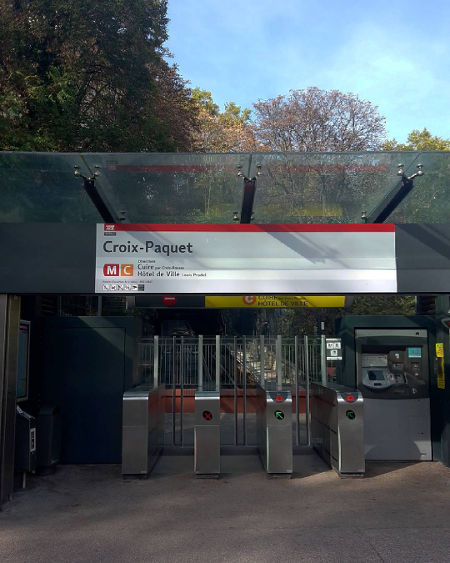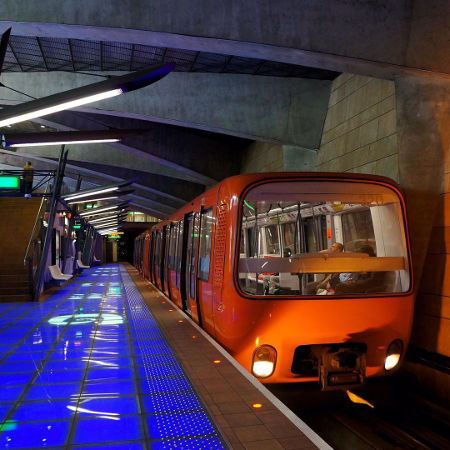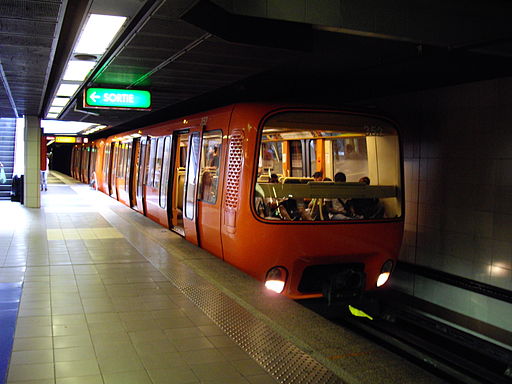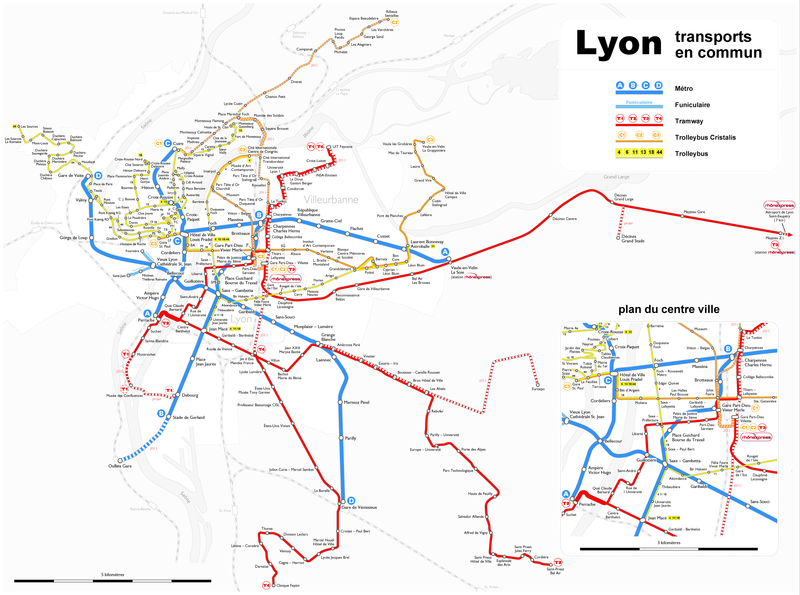Lyon metro serves the french city of Lyon since 1978. It has 4 lines and 42 stations. Most of its 31,5 kms of tracks run underground, except for a Line C section. Its public transport system consist of buses, trolleybuses, trams, light rail, funiculars, metro and regional trains. Most of them are operated by TCL (Transports en Commun de Lyon). Lyon Metro daily ridership is over 700,000 passengers.
Lyon Metro: Abstract
Lyon has one of the largest public transportation networks in France, being second only to Paris. It draws inspiration from the Metro in Montreal, Canada. Lyon Metro is a public transportation system owned by TLC. It was opened in 1978. There are multiple museums for tourists to visit within the range of the metro. It connects to other railway networks such as Rhonexpress. Most cars in Lyon Metro use rubber tires. Most of the driving system of the cars is either partially or fully automatic. The metro’s ticket can be used for transferring to other vehicles, such as buses and tramways. It starts operations at around 4:30am, and runs until midnight. It has 40 stations, comprised of four lines. The metro accepts either tickets or cards. Its ticket prices start at two euros.
- Known as: metro
- System length: 31.5 km (80% underground)
- Number of lines: 4
- Number of stations: 42
- Website: www.tlc.fr
- Operator: TLC (Transports en commun lyonnais)
- Average ridership: 708,232 per day.
- Start of operation: 1978
About the system
Lyon is a relatively quiet city in France located around 500 km from Paris. It has a population of around half a million people, and it is one of France’s largest cities. Lyon is an important city and a touristic attraction famous due to its silk production, museums, food and also for being the birthplace of movies. There is a celebration in this city related to lights called Fete des Lumières.
A company called SYTRAL owns the metro and all of its machinery but the system itself is owned by the Transports en Commun de Lyon (TCL) brand, which belongs to the Keolis Lyon. TCL is an agency which controls public transportation in the city of Lyon. It covers transportation of over 600 kilometers square.
 Lyon Metro
Lyon Metro
Car models were constructed by the company Alstom. The models are: MPL 75 (Metro Pneus 1975), MCL 80 (Metro Crémaillère Lyon 1980), and MPL 85 (Metro Pneus Lyon 1985.) While trains commonly use steel wheels, Lyon Metro’s cars use rubber tires.
It has four lines: Line A, Line B, Line C, and Line D. Line C is the only line that uses steel tires. The rest of the lines’ cars use rubber tires. Some of its stations have peculiarities, such as being on a steep mountainside, or having colorful decorations. In 2014, Lyon’s Metro got almost 200 million passengers. The metro goes at 80 km/h of max speed. Other public and private vehicle networks associated with Lyon Metro are: Rhonexpress, Dragonfly, Full Moon, Optibus, as well as trams, buses, and the trolley bus.
A little bit of history
Lyon had its first underground train in 1862, way before anyone else in the world had one. The first idea of an underground railway was made by the engineer Joseph Jaubert. However, this first draft was scrapped, and no rail was built. Then, in 1897, TCL and a competitor wanted funds for making an underground train. TCL won, and they made funiculars in Croix-Rousse. These funiculars were later adapted to line C of Metro Lyon. Later, a 14 station train network was planned, but the idea was later abandoned. The first successful draft for the metro was approved in July 22, 1963. Finally, Metro Lyon was built by a research metro company led by René Waldmann. It took around four years to construct the rails of line B, which started in 1973. Lines A, B, and C were ready by the opening day of Lyon Metro. Line D appeared in a later date.
The metro’s lines had multiple expansions. Line B was first expanded in 2000. In 2013, line B got expanded again, in which it got around 2 km of extra rails. Line C was expanded in 1984.
Lines and stations
Metro Lyon has 40 stations, divided into 4 lines: A, B, C, and D.
Line A
It has 14 stations. It is approximately 9 km long. It is identified by the color red. A trip in this line lasts for around 25 minutes. It uses MPL 75 trains. All of its trains use rubber tires. It opened to the public in 1978, and it was expanded in 2007. It has an everyday attendance of around 250,000 people. Its trains have three cars. The trains go above a river. It is driven by using a semi-automatic system. It connects to places such as: The Museum of Fine Arts of Lyon, Place of Terraux, City Hall, Opera of Lyon, House of the Book, Astroballe, Square of Silk, and the Hippodrome of Lyon. They also make trips to the airport, by making a connection with the privately owned Rhonexpress trains.
The stations are the following: Perrache Train Station, Ampère: Victor Hugo, Flachet, Foch, Vaulx-en-Velin: La Soi, Charpennes: Charles Hernu, Cordelier, Repúblique: Villeurbann, Laurent Bonneva, Bellecou, Cusse, Masséna, Hotel de Ville: Louis Prade, Gratte Cie
 Station in Lyon
Station in Lyon
Line B
This line has 10 stations. It is identified by the color blue. Its length if of approximately 8 km. A trip lasts around 20 minutes. Its trains use rubber tires. The train is semi-automatic. Although its train cars have drivers, there are plans to convert this line to be fully automatic. It uses MPL 75 cars. It has a daily attendance of around 130,000 people. Most of its rails have a single track. There are also plans for expanding this line to include two new stations. It goes to places such as the Part Dieu Shopping Center.
Its stations are: Debourg, State-de-Gerland, Brotteaux, Part Dieu, Jean Macé, Place Guichard: Bourse du Travail, Place Jean Jaurés , Gare d’ Oullins, Saxe: Gambetta, Charpennes: Charles Hernu
Line C
It has five stations. It is identified by the color orange. Its length of tracks is of approximately 2 km. A trip from end to end lasts around 10 minutes. It has a daily attendance of around 30,000 people. This line opened in 1974, before Metro Lyon existed. This line has trains of two cars. The trains use the car model MCL 80. This line is famous for having a steep slope. Unlike the rest of the other Lyon Metro lines, this line has steel wheel train cars. This railway system is manually driven. It goes to places such as the hospital, and the Museum of Fine Arts.
Its stations are: Bellecour, Croix Paquet, Hotel de Ville: Louis Pradel, Hénon, Croix-Rousse
Line D
It has 15 stations. It is identified by the color green. Its trains use rubber tires. A trip in this line lasts a little less than 30 minutes. It has around 270,000 passengers each day. It uses MPL 85 cars. This line is unique compared to the other lines because its cars are completely driverless. Another technology that makes this train’s cars unique is an infrared sensor that stops the trains if there is an obstacle in the tracks. This is why there are no doors to protect people from walking into the rails. The length of its tracks is of 12.5 km. This line opened to the public in 1991. It goes to places such as the Parilly Park, and the Historic Courthouse of Lyon.
The stations are the following: Gorge de Loup , Vieux Lyon , Gare de Vaise , Fnac Lyon Bellecour , Valmy , Part Dieu Villete Sud , Sytral , Laennec , Monplaisir: Lumiere , Garibaldi , Sans Souci , Cordeliers Bourse , Cuire , Mermoz: Pinel , Guillotiere
Funiculars
There are funicular stations associated with the Lyon Metro. They are the following:
Funicular Fourviére:
- 1) Fourvière
- 2) Vieux-Lyon: Cathèdrale Saint-Jean
Funicular Saint-Just:
- 1) Minimes: Thèatres Romains
- 2) Saint-Just
- 3) Vieux-Lyon: Cathèdrale Saint-Jean
Rail connections:
Lyon Metro’s cars can connect to other transport services at the following stations:
- 1) Charpennes: Charles Hernu (Lines A and B): Transfers to Lyon Tramways 1 and 4.
- 2) Debourg (Line B): Transfers to Tramway 1.
- 3) Oullins (Line B): Transfers to Rhonexpress.
- 4) Vaise (Line D): Transfers to Rhonexpress.
- 5) Venissieux (Line D): Transfers to Rhonexpress, and Tramway 4.
- 6) Part-Dieu (Line B): Transfers to Tramways 1, 3, and 4; Rhonexpress, Intercités, and TGV (high speed train.)
- 7) Gorge de Loup (Line D): Transfers to Western Lyon Tramway.
- 8) Grange Blanche (Line D): Transfers to Tramways 2 and 5.
- 9) Guillotiére-Gabriel Péri (Line D): Transfers to Tramway 1.
- 10) Perrache (Line A): Transfers to Rhonexpress.
- 11) Jean Macé (Line B): Transfers to Rhonexpress.
- 12) Sans Souci (Line D): Transfers to Tramway 4.
- 13) Place Guicard-Bourse du Trovail (Line B): Transfers to Tramway 1.
- 14) Vieux Lyos: Cathédrale Saint-Jean (Line D): Transfers to Funiculars 1 and 2.
- 15) Vaulx-en-Velin La Soie (Line A): Transfers to Tramway 3.
Connection to airport:
Saint-Exupéry Airport is Lyon’s airport. Currently, the only way of getting to Lyon’s airport is through the privately owned Rhonexpress. The closest Lyon Metro station is line B in Part-Dieu. The trip from Part-Dieu to the airport lasts around 30 minutes. To get to Part-Dieu from the airport, take Tramway 3 (also run by TLC). From there, take a Rhonexpress train.
Schedule, timetables, and hour of operations:
The timetables for each line are the following:
- Line A: Perrache’s station starts at 5:00 am, and ends service at 12:20 at midnight. Vaulx-en-Velin La Soie’s station starts at 4:35 am, and stops service 12:20 at midnight.
- Line B: Charpennes’ station starts at 4:50 am, and ends service at 12:20 at midnight. Gare d’ Oullins’ station starts at 4:50 am, and ends at 12:10 at midnight.
- Line C: Hotel de Ville’s station starts at 5:00 am, and ends at 12:25 at midnight. Cuire’s station starts at 5:00 am. This last station normally ends service at 12:10 at midnight, but it sometimes ends at 11:50 pm. Henon vers Hotel de Ville’s station starts at 4:50 am.
- Line D: Gare de Vaise’s station starts at 5:00 am, and ends at 12:20 at midnight. Gare de Vènissieux starts at 5:00 am, and ends at 12:10 at midnight.
Parking services for cars are available from Monday to Sunday, from 1:30am to 1:00am.
Price, tickets, and cards
In Lyon Metro, as well as other public vehicles owned by TCL, a person could use the same ticket for all vehicles during one hour without needing to validate the ticket. TCL gives information and offers Lyon’s Metro tickets from Mondays to Saturdays. TCL gives tickets and information from Monday to Friday, from 7:30 in the morning to 7:00 in the evening, and on Saturdays, from 9:00 in the morning until 6:00 in the evening.
There are two ways of buying tickets for the metro. The first ways is by buying tickets via vending machines. There are over 400 ticket vending machines at the metro stations. The second way of buying tickets is via TCL shops. There are a total of four TCL shops.
A single ticket can take you to any distance, and it can be used for transferring into a bus, tramway, or funicular. It can be used only for one hour from when the ticket was validated. The same ticket can be used as a return ticket, as long as it is used within the hour period.
Single tickets
- Ticket: A 1.80 euro ticket. Works for one hour for a single person. It works in all vehicles.
- Ticket on the buses: A 2 euro ticket, which only works for buses, and only for emergencies.
Liberté tickets
- Liberté 1 jour: A ticket for 5.50 euros for one day unlimited for a single person.
- Liberté Soireé: A ticket for 3 euros for rides from 7:00pm until vehicle transportation ends. This ticket needs to be checked at each transfer.
- Liberté 2 heures: A 3 euro ticket. This ticket is unlimited for two hours.
Specific tickets:
- TCL en Fete: A 3 euro ticket. This ticket is special for festivities at night in the Lyon area.
- Ticket Funiculaire: A 2.80 euro ticket. This ticket is also used for special festivities in Lyon.
- Group ticket: A 10 ticket bundle, where each ticket is 1.40 euros. This ticket is only for groups of over 9 people. It lasts for an hour. It works for the Lyon Metro, as well as all of the public transportation in Lyon.
- Twinned tickets: A ticket with contingent price. This ticket works for rides to museums and other recreational places. It ranges from six euros to 23 euros.
- TCL Pass: Another ticket with contingent price. It also works for groups of over 9 people. This ticket could last for one or many days.
- Lyon City Card: There is a card for paying for the metro. Its price ranges from 13.5 to 17 euros. It lasts for one, two, or three days.
You can pay a subscription for students (both national and international) who are under 29 years old. To obtain it, you need to bring the following to a TCL office:
- A debit card, credit card, or cash to pay the first monthly payment.
- A passport or ID.
- An ID photo.
- Five euros.
- Your Social Security Card or student ID.
- Bank information if you choose a monthly payment plan.
This student card lasts for five years. You need to keep money on the card on a monthly basis. It is valid until the final day of the month. The plans available are month-by-month and year-by-year. The month-by-month plan charges you 29 euros, while the year-by-year plan charges you 290 euros.
Parking at Lyon Metro
There are parking facilities for metro and bus users. Try not getting to late. It's free of charge if you hold a TLC ticket or Card.
- Laurent Bonnevay (680 places) - Terminus métro A
- Stade de Gerland (400 places) - Terminus métro B
- Cuire (80 places) - Métro C (réservé abonnés)
- Gare de Vaise 1 (490 places) et 2 (780 places) - Terminus métro D
- Gorge de Loup (680 places) - Métro D
- Mermoz-Pinel (140 places) - Métro D
- Parilly (140 places) - Métro D
- Gare de Vénissieux (380 places) - Terminus métro D
- IUT Feyssine (100 places) - Terminus tram T1
- Porte des Alpes (390 places) - Tram T2
- Bel Air / Saint-Priest (120 places) - Terminus tram T2
Rules in Lyon Metro
- Smoking’s not allowed in the metro.
- Bikes, scooters, and other portable vehicles are not allowed either in the metro.
- Do not speak to the driver while he is driving.
- It is recommended to give your seat to a disabled or pregnant person if needed.
- All activity on the metro is recorded on camera.
- Have your money prepared in advance.
- Validate your tickets or metro card in the metro, or the transfer buses or tramways.
- Tickets can be checked at any time while within the vehicle.
Future expansions
Line D will get 30 new trains. Lines A, B, and D will also have more trains. There are four more metros with rubber tires planned to be added to lines A, B, and D. They will be able to transport around 300 people. These new trains will be 36 m long. Also, these new train’s brakes will work using only electricity.
Tips
- Travelling in Metro Lyon is one of the most recommended ways to travel in the city because of its speed.
- If you want to bring pets with you, bring kennels or cages, since only caged animals are allowed.
- Do not take pictures of the metro, since you will be escorted out of the vehicle by security.
- Park and ride services for people bringing their cars are offered.
- Cars can be parked at no cost if you have a metro ticket.
- Metro Lyon also offers pay to park services for cars.
- The language spoken in the metro is French, so it is recommended to know French.
Curious facts:
- Over 75% of the metro lines are below ground.
- The Metro Lyon trains run on the left side of the tracks, even though people in France drive on the right.
- Over 650,000 people use the metro per day.
- The loading gauge of the cars are of approximately 2 m.
- All train cars used to be orange, until they got refurbished in the 90s.
- The stations in Line D have a colorful design. Its floor tiles have lights that turn on in varied patterns.
- The reason why the metro uses electric brakes is that it saves energy.
Nearby attractions
There are 22 museums within the metro’s reach, including the Museum of Fine Arts. There is also the Mini World Lyon Park. Also, a boat trip on a river is available.
There are many attractions a places of interest for tourists within the range of Lyon Metro. Among them are the following:
- 1) Museum of Fine Arts in Lyon: second only to Louvre as a fine arts museum. There is art from Egyptian times all the way to contemporary art. The collection of art is astounding. It has famous paintings such as Perugino’s Ascension of Christ.
- 2) Museum of Archaeology: Shows relics from Gallo-Roman times. Also has digging site within less than 400 m, where some relics were found.
- 3) Old Town of Quartier Saint-Jean and Saint Georges: These old towns have cobblestone roads. It also has old-fashioned restaurants. You can also find the History Museum of Tyon, and the Puppet Museum.
- 4) Steep hill town at Croix-Rousse: It is a town built on a mountainside. This town has historic value. There are secret roads, called Traboules, which serve as a way to travel from roads to houses.
- 5) Presqu’ile District: Town with gorgeous architecture. Surrounded by the Garonne River. It has a famous building called Palais de la Burse et du Commerce. It also has an elegant plaza area.
- 6) Restaurants: Cuisine in Lyon is world famous. There are salads, and a variety of meals of meat-related dishes. Some of the recommended places to go are the Bouchons, which are authentic old-fashioned French restaurants.
- 7) Basilique Notre-Dame de Fourviére: This church is over 100 m tall. It is located near the Saone River. It boasts a combination of Byzantine and Gothic designs. You can climb to the highest tower to get beautiful views of Lyon. Near the church is Esplanade de Fourviére, where you can get another beautiful view of the city of Lyon.
- 8) Musée des Tissus and Musée des Arts Decoratifs: Two museums inside an old mansion. One is an art museum, while the other is a fabric museum. The fabric museum shows the history of silk commerce of Lyon. Some of the most beautiful exhibitions in this museum are the doublet of Charles de Blois and the Tree of Jesse. The museum of art shows antiques from the 16th century. Most of the exhibitions in this art museum are things used by the rich family that lived in the old mansion.
Some Lyon Metro pictures
Lyon Métro map
- Also Known As: Métro
- Passengers/Day 708232
- Fares: 1.60
- 24h operation: No
- Air Conditioning: No
- Walk between platforms: No
- Driverless trains: Line D/Maggaly, rubber-tyred, no PSDs (since 1991)
- Screen Doors Platforms: No
- Operator: Keolis Lyon
- 1.80 Euros
- Lyon Metro Official Website
Help us
If you consider that the information we provide is wrong, not accurated, outdated, translation contains errors, and you would like to help us to improve the file...you can contact us here.
Feel free to contact us if you dont find the system you're looking for and we'll add it as soon as we can!
Thank you very much!









